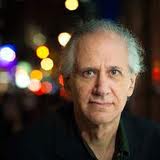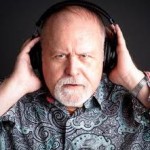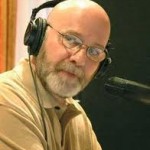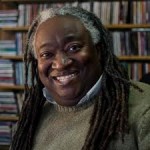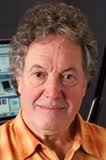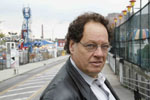Poet/playwright/critic  Allan Graubard has been a close friend and collaborator with Buch Morris, writing highly descriptive and evocative notes for Testament: A Conduction Collection  as well as their theater work, “Modette,” and the liner notes below, intended for the 25th anniversary re-issue of Conduction #1, Current Trends in Racism in Modern America, A Work in Progress. I posted my own notes to that edition yesterday.  Allan also was working in the months preceding Butch’s death January 29 to complete his long-in-progress book about conduction.
Beginning… an OeuvreÂ
Opening
With silence, a sudden flourish, Conduction premiers in 1985. Not pure ensemble improvisation or notated orchestration, its vivacity is clear, its horizons large. By 2010, an exceptional oeuvre sustains its purpose.
“With a few exceptions, Conductions were created with no notation, preconceived idea as of what was to be performed or tonal centers (keys), only knowledge of the Conduction lexicon.  The idea was and is to see/explore how effectively the lexicon could be extended to accommodate each ensemble…and to see how broad and sturdy it is when integrating notation with Conduction (or Conduction with notation).†– Butch Morris (personal communication 2010)
Insistent and delicate, abrupt or gracious, this first Conduction carries an orchestral sensibility that Mr. Morris exploits as Conduction matures, with a current chronology nearing 200 works. For us nothing has changed. We seek Conductions that sing.
Enrichment
Butch Morris plays Conduction #1 with four signs, one of which he no longer uses. In 2010 the ductility of the form has grown apace, with (approximately) 48 signs and gestures and 13 different categories of signs and gestures – refining its capacity to isolate and shape musical structures as they appear, with all their tensions, releases, reflections and epiphanies.
How did this take place? What has Butch Morris done to hold us through his performances, workshops, lectures, interviews and writings? In what ways has Conduction valorized ensemble creation, the art of conducting, the discipline of composition and the vitality of music and musicianship?
Beyond his vision, sensitivity and perseverance – each quite necessary to support the effort – answers involve a host of issues intimate with our understanding of music, and the contribution that Conduction makes to music:  from musical method, culture, tradition, power, intelligence, emotion, to how we know them and how they inter-relate.
By integrating the social act of conducting with the solitude required for sustained composition, Mr. Morris asks of the ensemble that it assume a unique expressive identity rooted in an expansion of responsibility; the moment by moment creation of the work in real-time.
Enrichment here is reciprocal and multifaceted. Its effects, while initially fascinating, carry other distinctions, which we, because of Conduction, approach anew. I include quite necessary redefinitions and recalibrations, especially in terms of virtuosity and the place of the virtuoso within a medium where the “solo†has little meaning per se, equally idiom and style.
The Terms Evolve
Conduction fuses composition with conducting. Participants build the work through dialogue, precise to the values they bring and those they encounter:Â between conductor and ensemble, musicians and conductor, musician and ensemble, conductor and audience, the ensemble entire and audience, and the venue; this emblazoned space.
As the act of composition infuses the ensemble, attentiveness, precision and playing clarify. The conductor leads and responds. The Conduction asserts and discovers.
In one sense, Conduction frees the ensemble, and Conductor, from a specifically lexical determination through notation. In another sense, it questions an expectation that lexicality is a matter of interpretation, not of creation, and that improvisation is a matter of creation exclusive of interpretation. For its audience, Conduction is drama — heterogeneous, homogenous; an arc that intensifies the rapport available to it. Yes, Conduction distinguishes the space it has made its own, with surprise its chorus.
Relative Time
It is revealing, even briefly to compare, Conduction #1, “Current Trends of Racism in Modern America,†to Conduction #146, “Relative Sea,†with the HKB Orchestra, Bern Switzerland, October 7, 2005, some twenty years on.
From an initial nonet of NY improvisers plus voice, there is now a European orchestra of 63 musicians, without improvisers. From a title given to American racism, there is reference to Einstein’s Theory of Relativity and Debussy’s La Mer.  Strikingly, while the circumstances, organization and metaphorical contexts have changed, the artistry commands in both Conductions as much for the music as the means of its making and the excitement of its reception.
Whatever their scale, the accents, colors and movements of any one Conduction enlighten other Conductions, depicting a method for collective intelligence and expression that speaks to the community or communities it comes from, and other communities drawn to it.
Mr. Morris has discussed Conduction #146, “Relative Sea,†performed, by the way, on the 100th anniversary of Einstein’s theory and Debussy’s music: “Relativity depends, among other things, on ‘reference frames’, which is exactly what Conduction is. Why is it that people look so deeply into or at the sea? Is it because they can determine their own reference? Conduction is an excellent bridge between relativity and the sea.â€Â And, I might add, between the relative comportment of ensemble musicians and the thermal, tidal, wave and wind forces of the music they make.
A Chronology
Conduction engages musicians from different traditions, nationalities, cultures, backgrounds and accomplishment worldwide. In the chronology of Conductions, there are those of special significance for Mr. Morris, of course; I will note only several.
Conductions 62-64, with the Maarten Altena Ensemble, are exemplary for “their great open minds,†the ensemble’s ability to explore and enhance the interchange. Conduction 28, “Cherry Blossom,†involves indigenous Japanese musicians, whose attack — “earthy, not Western in any way, so immediate and daring†– opens up new routes and implications for cultural dialogue. Later, in Conduction 100-101, he combines indigenous Japanese and Turkish musicians with NY improvisers. Conductions 57-59, “Holy Sea,†with the Orchestra della Toscana, his first with a classical orchestra for whom Conduction is an unknown, brings splendid results. The prospect it opens on classical musicianship and musicality is both provocative and foundational for future engagements with other orchestras. Conduction 81-87, “London Skyscraper,†maneuvers to forge for its personnel, all improvisers, “leaps in ways other than improvisatory.†There is Conduction 27, the first with text vocalization (A Chorus of Poets), and Conduction 187, “Erotic Eulogy,†the first with full text written specifically for the chorus, with string ensemble; where Mr. Morris “accommodates and registers both ensembles, each formed in their own way, each given their own direction.†Conduction 115 visually transmits the conducting to three different ensembles in different rooms in one locale, a template for live cross-continental performance of a kind unheard before. His Conductions in theater works, and the use of Conduction as a principal medium in developing a theater work, touch new possibilities. And others here and elsewhere…
Implications  Â
In recognizing the divide between notation and improvisation, Conduction appeals to interpretation: of the conducting signs and the ensemble’s response, and quality of that response, to them. As a supplement to music and musicianship, it provides a distinctive pedagogy with new values brought to capacity, attack, judgment, culture, tradition and communication. To compose the ensemble as it composes the work extends our notion of what does or does not qualify as a work, whether as product, process, or their various similitudes. As an inimitable “extra dimension†in music, it compels; perhaps because of the risk it entails and the acuity it requires from all participants.
Conduction has provided a synthesizing vector that we have yet to take full advantage of, especially in terms of poetry, theater, dance and architecture. When performance becomes a fulcrum for dialogue between the individual and the collective, here in the service of music, but just over there in the service of ideology and power, other questions resonate — from what we endure, augment and critique, to what we celebrate or subvert as communities within a politically charged history.
The coherence that Conduction can bring to multiplicities (however existential, discontinuous or coterminous they are), and the capacities it can invest in static bodies, return us to its music, but also to the cultures that music comes from, the social logics thus embodied and the structures erected in their, and our, names.
Fortunate it is that we can chart, in each Conduction, the interactions that feed its momentum, ever attuned to the discipline and its delights.
Conduction does not conclude…
From its first appearance to its current embodiment, Conduction has given us marvelous affirmations of music and its larger meaning in the world. I see no end to this endeavor that enriches the spirit that moves us in music, and the passion and compassion that composes, from this movement, something new, something beautiful – something that is and will be.
But where is a Conduction orchestra or ensemble dedicated to the art and sustained with the kind of support that will make use of the Conduction lexicon in its entirety? This is a place we have yet to experience: practitioners, students, researchers, artists, writers, critics and audience alike. With 25 years of Conduction before us, its time has come. — Allan Graubard, c 2010

